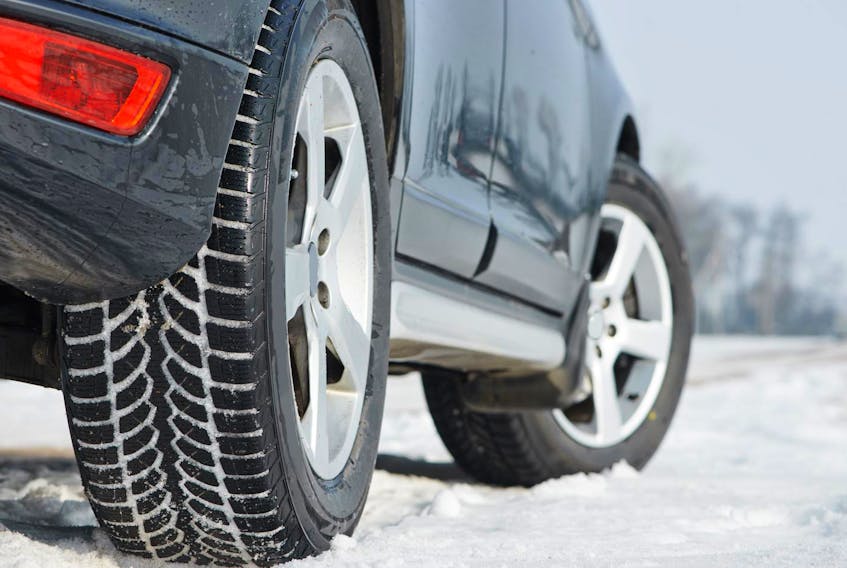There’s a new tire in town — the all-weather tire. Not all-season, but all-weather. The difference in name, unfortunately, does not reflect the difference in performance and safety.
I’ve always thought of all-season tires as compromise or three-season tires.
They are the jack-of-all-trades and master of none. Good, but not great for spring, summer and fall, but not good for winter. The issue is the ambient or outside temperature.
Many components
A tire is a mixture of natural and synthetic rubber, steel or fibre belts, binders, polymers, oils, carbon black, silica and even small pieces of nut shells. The proportions are a closely guarded secret.
This complex combination of tread and compound determines everything from grip to wear and noise levels.
All-season tires are designed to remain effective at temperatures ranging from seven to 30 degrees C. As you exceed either end of that scale, they become too hard or too soft. Below seven degrees, they become hard and lose their effectiveness. Above 30 they become very supple and wear incredibly quickly.
For this reason, pure winter tires hugely out-perform them during the cold months and pure summer tires are much better in hot summer conditions.
During numerous tests, on ice, I have witnessed vehicles on a set of all-weather tires require 20 per cent less distance to come to a stop than an identical vehicle on high quality all-season tires. Pure winter tires add an additional 15per cent advantage.
The problem in Canada is that we spend a great deal of time driving in temperatures below seven degrees. As a rule, that includes at least one quarter of the year — December through March. D
uring this period, all-season tires, by their very design, have greatly reduced capacity to provide safe traction while braking and turning.
The three peaks
You will notice I have made no mention of snow or ice.
Obviously, if all-season tires are not effective in cold weather — wet or dry, they will be less so when the surface is slippery.
Winter tires have a tread designed to cut through and dispel snow or slush.
Their compound is designed for cold conditions and they carry the all-important three-peak mountain snowflake (3PMSF) symbol, indicating they pass rigid tests for cold operations.
Very few consumers know that all-weather tires exist; nor do they understand how they differ from all-season tires.
A massive amount of science and chemistry differentiates the two. The only visual difference is that small 3PMSF pictogram.
This seal of approval indicates the tire has been tested and is capable of at least 110 per cent of the traction of a reference all-season tire.
This test tells us more than the vague M+S marking, which refers to tread design, not the compound beneath. M & S (mud & snow) on the sidewall is meaningless, there are no tests to pass and manufacturers can, and do, put them on any tire they like.
A Great compromise
All-weather tires provide similar grip on wet, dry or pure ice as a winter tire.
In addition to a different, usually more aggressive, tread design, pure winter tires, are compounded to remain flexible to even lower temperatures.
All-weather tires are thus a great compromise for Canadian conditions, and for those who travel south for the winter months. They eliminate the need for two sets of wheels and tires, and the added costs associated with storage and swapping twice a year.
For this reason all-weather tires got their beginning and are most popular in northern Europe where winter tires are compulsory.
They have obviously also become prominent in Quebec, where the same rules apply. Unfortunately, they do not come as standard equipment on new vehicles.
Most major tire companies now offer all-weather tires, including B F Goodrich, General, Goodyear, Hankook, Kumho, Michelin, Nokian, Toyo, Yokohama and Vredestein. Please consider that here is a clear case of getting what you pay for. A tire purchase is the one area where you can improve the safety of your vehicle and the protection provided the occupants.
One last tip
When purchasing new tires in pairs, put those with the best tread or grip on the rear of the vehicle whether it is front or rear wheel drive.
Putting them on the front will greatly increase the likelihood of an oversteer situation or loss of grip at the rear during a panic or emergency situation.
You probably don’t wear sandals or open toe shoes in winter, so why trust your safety to vehicles similarly ill-equipped?
If you store your vehicle for the winter, all-season tires will suffice. If you go south for the winter, live in an urban area where snow is cleared on a regular basis, or can park your vehicle during a winter storm, all-weather tires might be the answer.
If you “must” drive, regardless of conditions, get a set of high-quality winter tires.









